Reptile & Amphibian
News Blog
Keep up with news and features of interest to the reptile and amphibian community on the kingsnake.com blog. We cover breaking stories from the mainstream and scientific media, user-submitted photos and videos, and feature articles and photos by Jeff Barringer, Richard Bartlett, and other herpetologists and herpetoculturists.
Wednesday, April 30 2014
You don't normally think Burmese pythons when you hear about therapy animals helping kids, but that's just what they're doing at Nova’s Ark in Brooklin, Ont.

Read about it here.
Photo: MSN Canada
Monday, April 28 2014
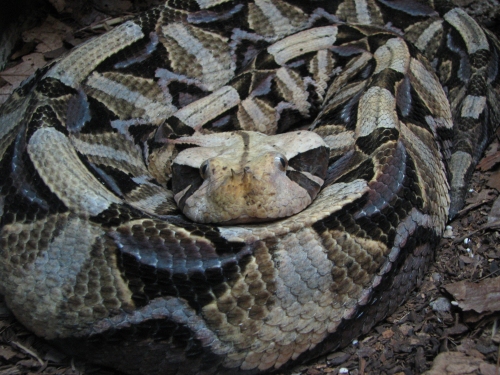 Now, see, this is what we mean when we say "decent media reporting about snakes where the reporter actually takes a few minutes to do his or her job," which is something we don't get to say much.
Sadly.
So thank you, Brian Hicks, of the Post and Courier, for pointing out that the media frenzy over the Gaboon viper threatening a small South Carolina town is probably based on... absolutely nothing.
Read it here.
Photo: Wikicommons, released to public domain
Friday, April 25 2014
Check out this video "Boa on a stroll," submitted by kingsnake.com user Minuet.
Submit your own reptile & amphibian videos at http://www.kingsnake.com/video/ and you could see them featured here or check out all the videos submitted by other users!
Thursday, April 24 2014
 Nothing must ever happen in South Carolina, given the insane levels of hype over a supposed stray Gaboon viper roaming its streets. So with all that free time and dearth of current events to report on, you'd think the media could, you know... investigate? Or maybe just hit Wikipedia? Anything other than what they've been doing.
From the Charleston Post Courier:
Michelle Reid, of Animal Rescue and Relief, removed the traps and gear Monday after learning that the nearest any antivenin can be found is Africa, and the antivenin can't be brought to the United States until the Federal Food and Drug Administration approves it. She is trying to get that approval.
We thought this seemed implausible, so we checked with Jim Harrison over at the Kentucky Reptile Zoo. This is what he had to say:
Unfortunately, the media did no research on the subject. At the very least, two facilities carry South Africa polyvalent antivenin . They are Riverbanks Zoo and Alligator Adventure. We at Kentucky Reptile Zoo have over 30 vials at the moment of the antivenin. Further more, their experts are lacking as well with their information on trapping as well as the natural history of the Gaboon. It appears they may have spent their time watching Animal Planet rather than researching the real husbandry of the the species.
There's a few facts for you, South Carolina media. You're welcome.
Photo: Wikicommons, released to public domain
Wednesday, April 23 2014
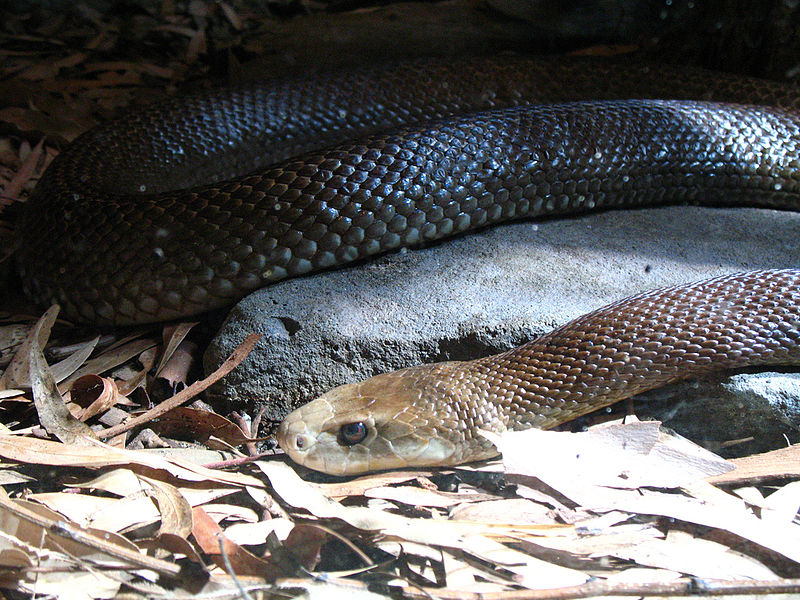 Venom from Australian snakes is helping save human lives. Seriously ill patients are benefiting from shorter turnaround time on critical blood tests, thanks to the coastal taipan ( Oxyuranus scutellatus) and the Eastern brown snake ( Pseudonaja textilis).
From ABC Australia:
The bites of eastern brown snakes and coastal taipans are dangerous because their venom causes a victim's blood to coagulate.
Researchers at the University of Queensland have pioneered a way to use snake venom to speed up the processing of blood tests of patients who have been given anti-coagulants.
Dr Goce Dimeski says tubes infused with snake venom are producing faster and more accurate results.
"From a clinical perspective, results will be available in a shorter time," he said.
"There's a potential to decrease the length of stay for patients, increase patient throughput and in the end could lead to saving lives."
Read more...
Photo: Denise Chan/Used under the Creative Commons Attribution-Share Alike 2.0 Generic license.
Tuesday, April 22 2014
A fire in a Savannah Reptiles Planet warehouse in France killed between 20,000 and 30,000 reptiles and another animals.
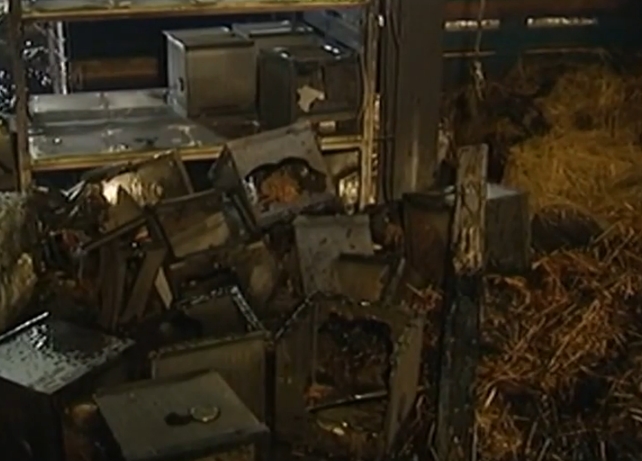
From Prensa Latina:
The flames destroyed around 4,000 square meters of the facility and killed a large number of snakes, iguanas, chameleons, lizards, amphibians, rabbits, rats, and insects.
Only eight turtles, between 60 and 100 kilograms, were saved, when rescuers poured water on their shells.
Read more...
Image: France TV
Monday, April 21 2014
There's a pretty flipping cool photo spread of crocs in nature in the UK's Metro. See it here.
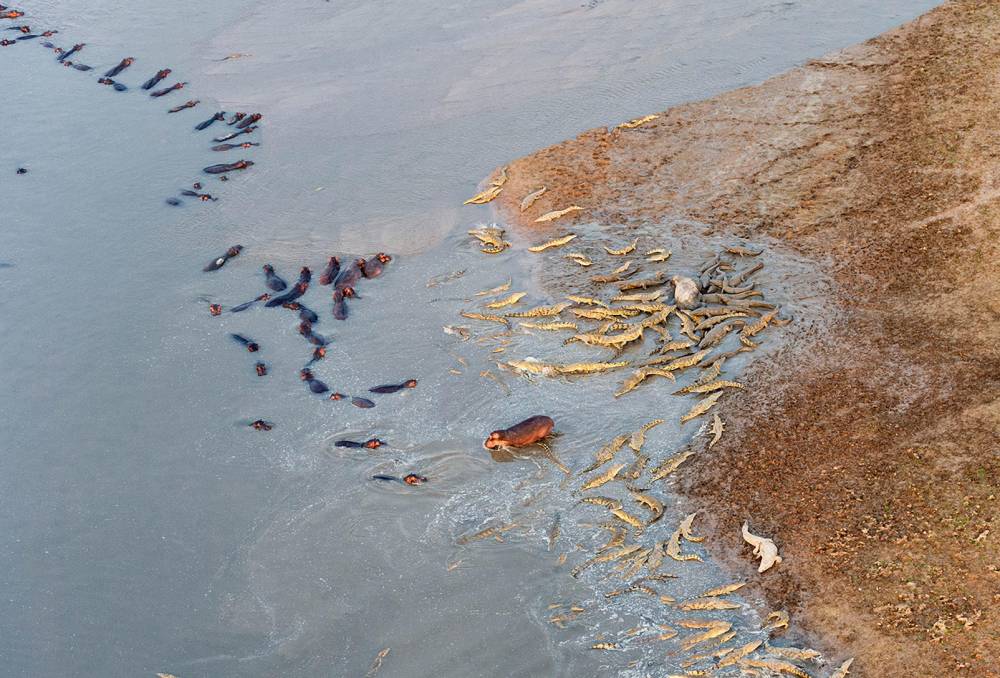
You're welcome.
Friday, April 18 2014
Check out this video "Bearded Dragon VS Superworms," submitted by kingsnake.com user Minuet.
Submit your own reptile & amphibian videos at http://www.kingsnake.com/video/ and you could see them featured here or check out all the videos submitted by other users!
Thursday, April 17 2014
We've heard of snow days... but snake days?
A high school in Kyrgyzstan was closed down after they found at least 30 snakes in the building every day this spring. No ID was made of the types of snake, but media speculation has ranged all over the place, including the Caspian cobra, Naja oxiana.
 Read more...
Photo: Omid Mozaffari, licensed under the Creative Commons Attribution-Share Alike 3.0 Unported license.
Read more...
Photo: Omid Mozaffari, licensed under the Creative Commons Attribution-Share Alike 3.0 Unported license.
Wednesday, April 16 2014
What if there was a disease that killed or crippled hundreds of thousands of people every year, but no one seemed to care?
It's not a disease, but as Dr. Matthew Lewin wrote in the New York Times Sunday Review last weekend, snakebites kill 94,000 people and cripple 400,000, mostly in impoverished parts of the world.

So where are the telethons, the philanthropic dollars? Where are new developments other than costly, mostly unavailable anitvenin? How about drugs, or a snakebite EpiPen?
Find out...
Photo: Naja annulifera by kingsnake.com user Neverscared
Tuesday, April 15 2014
Did you hear the one about the man who got out of his car to get a closer look at an alligator... and got bitten by a water moccasin?
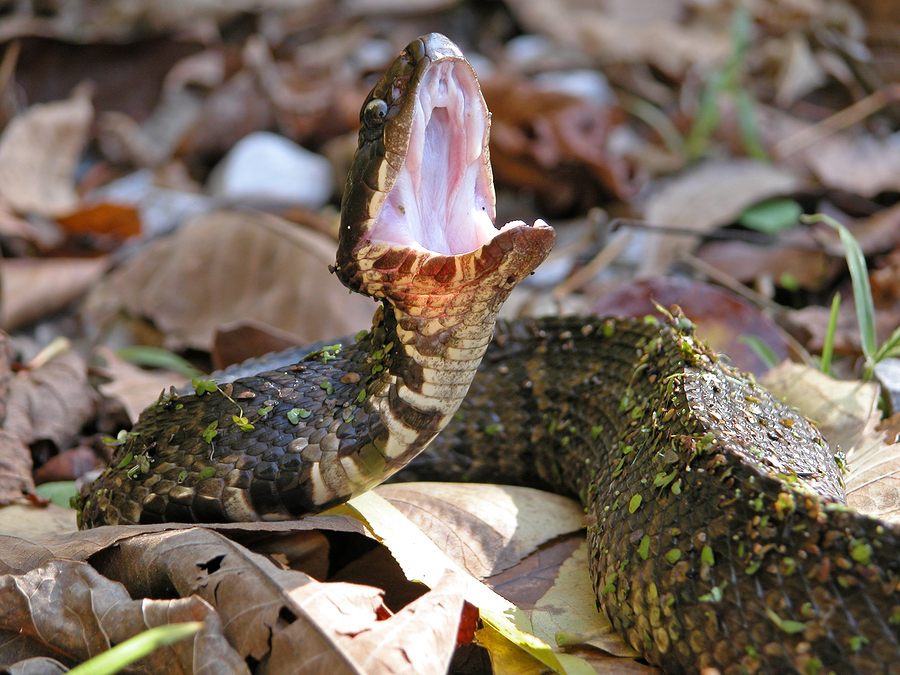
No, it's not a joke. It's a true story from WTSP in Tampa. Read it here.
Monday, April 14 2014
Some people in a Mississippi town might have had turtle soup on their minds when they rescued a huge snapping turtle from a storm drain, but they quickly changed their minds and decided to save him, instead.
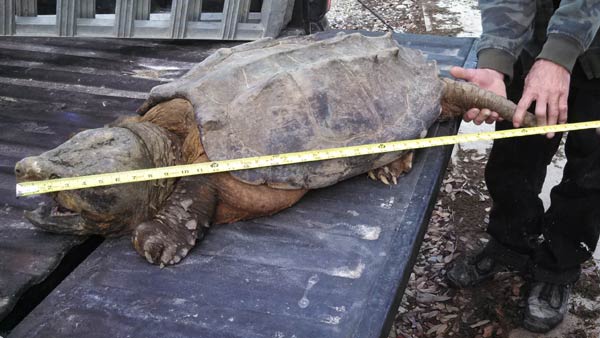
Read the story at KPTV.com.
Sunday, April 13 2014
Are poachers stealing and selling the golden lancehead pit viper ( Bothrops insularis) from an island off the coast of Brazil?
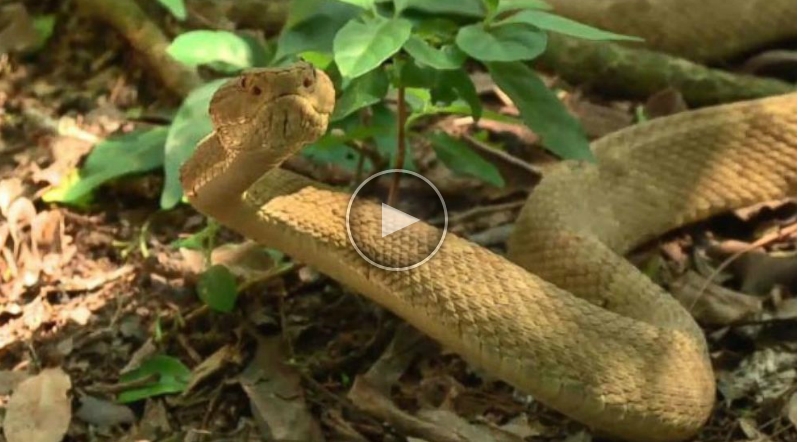
That was the topic of last night's Nightline Prime:
One poisonous bite from the Golden Lancehead pit viper is enough to kill a grown man within a few hours. It’s fast-acting venom will burn through flesh and cause its victim to bleed to death.
Rogerio Zacariotti, a researcher with the Cruzeiro Do Sul University in Brazil, travels to “Snake Island” regularly to monitor the Gloden Lancehead population. He is convinced poachers are stealing the snakes from the island and selling them on the black market.
Zacariotti allowed "Nightline Prime" to accompany him and his team on one of his research trips to "Snake Island," where ABC’s Dan Harris had some too-close encounters with the deadly snakes.
Read more and watch the video...
Friday, April 11 2014
Check out this video "Elvis the croaking frog," submitted by kingsnake.com user Minuet.
Submit your own reptile & amphibian videos at http://www.kingsnake.com/video/ and you could see them featured here or check out all the videos submitted by other users!
Thursday, April 10 2014
 Will the 'family fun' that is the Sweetwater Rattlesnake Round-Up in Sweetwater, Texas, ever be stopped?
From CNN:
The Jaycees, short for the U.S. Junior Chamber, bills itself as a group that gives young people "the tools they need to build the bridges of success." The Sweetwater branch has been holding what it calls "The World's Largest Rattlesnake Round-Up" for 56 years on the first weekend in March, and the tool for success that it teaches young people is that it's fun to kill and torture animals.
For weeks or even months, rattlesnakes are stored in crowded barrels until it's roundup time. The snakes that have not suffocated under their kin arrive hungry, dehydrated, and sick from gasoline that was sprayed into their burrows to flush them out.
After a tour of the roundup, Michael Smith wrote an article for "Cross Timbers Herpetologist" in which he recalls noticing "...an unusual smell ... like bad cologne and also like something gone bad." Throughout the tour the smell keeps coming back to him, he writes, until he realizes what it is: "...the musk, feces, and blood of a thousand terrified snakes, half-covered with sprays of deodorant from Jaycees working the pits."
Read more...
Wednesday, April 9 2014
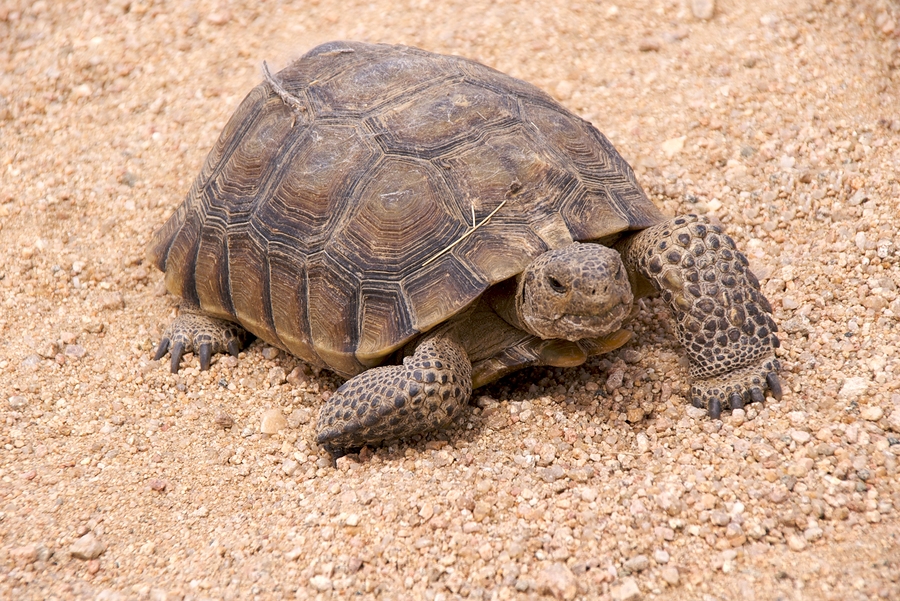 Can the conservationist and the cowman be friends? Not if you're Nevada rancher Cliven Bundy, who posted a challenge to the BLM on his ranch's website protesting efforts to save the desert tortoise ( Gopherus agassizii), saying, "They have my cattle and now they have one of my boys. Range War begins tomorrow."
From ABC News:
Bundy's beef with federal land management officials dates back to 1993, according to federal officials, when Bundy's allotment for grazing his cattle on public land was modified to include protections for the desert tortoise. Bundy, who told the Associated Press his family has been ranching this part of Nevada since the 1870s, did not accept the modified terms, and continued to let his cattle graze anyway.
After legal maneuverings on both sides, a Nevada district court judge in 2013 permanently enjoined Bundy's cattle (some 900, by the government's count) from grazing on public property. The judge reiterated that decision in 2013 and authorized the U.S. government to impound the cattle.
The first phase of that impoundment started Saturday, with 58 head of cattle being removed from BLM land, federal officials said in an online statement. As of Monday afternoon, that number had risen to 134, BLM spokeswoman Kirsten Cannon told ABC News. Removing the rest of the trespassing cattle should take another 21 to 30 days, she said.
Bundy disputes the federal government's authority to take such action. The Nevada Sheriff's Office, he contends, is the only entity empowered to impound his cattle. The Bundy Ranch website calls the federal agents "cattle thieves."
Read more...
Tuesday, April 8 2014
A South Carolina community is feeling the fear after shed snake skins found near an apartment complex were identified as coming from the Gaboon viper, a venomous snake from Africa.

From ABC News:
When a pest control company came last week to do a regular checkup on the bait boxes at the complex, the exterminator found snake skins nearby, took a picture, and reported it to the management office.
“The skin was still moist, indicating it was freshly shed,” Jennifer Bailey, an employee at the Harbor Pointe Apartments, told ABC News today.
To identify the snake, the office contacted a snake expert hours later who came in and said that the skin came from a Gaboon viper, an exotic snake not indigenous to the U.S. Another local herpetologist confirmed the identity through a photograph the pest control took, Bailey said.
Read more...
Monday, April 7 2014
A San Antonio TV station is questioning whether the rattlesnake in a field of bluebonnets featured in a viral Facebook photo is alive, or a taxidermied and posed dead snake.
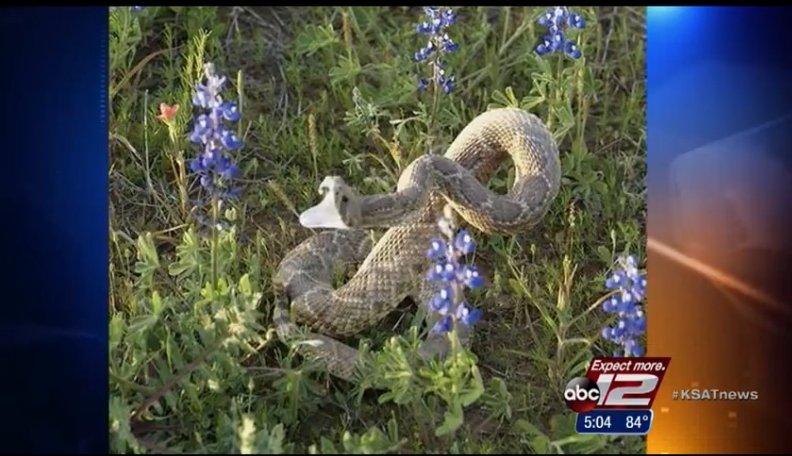
Given that the topic "snake in bluebonnets" has its own section on hoax debunker website Snopes.com, and it wouldn't be the first time a taxidermist has claimed to play this particular prank. it's a valid question.
From KSAT:
The picture, submitted to a news station’s Facebook page in Austin, shows a rattlesnake coiled among bluebonnets.
The picture has many reconsidering their annual trip to take pictures in the bluebonnets, believing it may be too dangerous.
Some experts, however, are questioning the validity of the picture.
"It’s a real picture,” said Blaine Easton, a snake expert with the South Texas Herpetology Society. “I'm not sure that snake is alive. I think the snake is dead and mounted by a taxidermist."
According to Easton, it is the snake’s neck position that causes him to question the picture. Easton said it did raise a valid concern.
"I have found in the middle of bluebonnets, on some ranches, rattlesnakes sitting there,” said Easton.
After all, Texas is home to 113 species of snakes. The moral, according to experts, is to just be cautious.
Watch their report...
Friday, April 4 2014
Check out this video "Turtle Cam," submitted by kingsnake.com user JoJoMang.
Submit your own reptile & amphibian videos at http://www.kingsnake.com/video/ and you could see them featured here or check out all the videos submitted by other users!
Thursday, April 3 2014
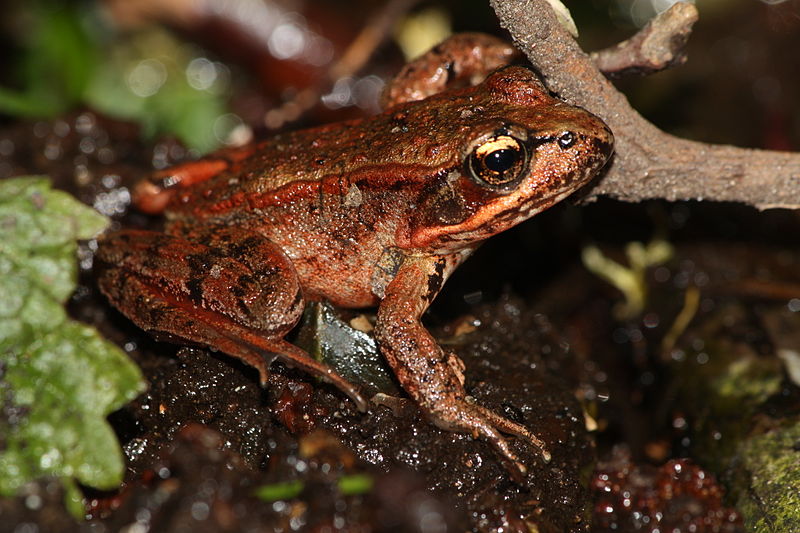 Frogs aren't well-equipped to migrate safely through the rush of automobile traffic. Last year, hundreds of protected northern red-legged frogs met their doom trying to cross an Oregon roadway. This year, things were different.
From Oregon Live:
After witnessing the N.W. Harborton Drive frog slaughter with his friend, Shawn Looney, Rob Lee started making calls and e-mailing biologists and herpetologists.
"I started trying to find the appropriate people to tell about this – that something was going on that we should be paying attention to," he says.
He also approached Jane Hartline, a retired Oregon Zoo marketing director and conservation advocate with a knack for organizing.
No one knew whether the great frog massacre of 2013 was an anomaly or, more likely, an unwitting annual death march. They were determined to find out, to help the frogs if they could, to precisely document everything they observed and to contribute to the scant science on the Forest Park red-legged frog population.
Liz Ruther, a habitat conservation biologist with ODFW, granted Lee, Looney and Hartline a permit to handle the frogs. Without one, it's illegal to touch or harass them, given the species' sensitive-vulnerable status.
With help from The Forest Park Conservancy, Hartline rounded up about three dozen volunteers willing to rush to Linnton with little notice. Their task: spend hours intercepting frogs on wet, chilly nights when most Portlanders were tucked in at home, dry and cozy.
Read more...
Photo: Walter Siegmund/Wikimedia Commons/Creative Commons License
Wednesday, April 2 2014
When the tiny island night lizard ( Xantusia riversiana) was first designated as threatened, kids were still putting safety pins through their ears and "God Save the Queen" was just released. But today, for the first time since 1977, it's no longer considred to be in danger.
The lizard is found only on four ilands -- or three islands and an islet -- off the California coast.
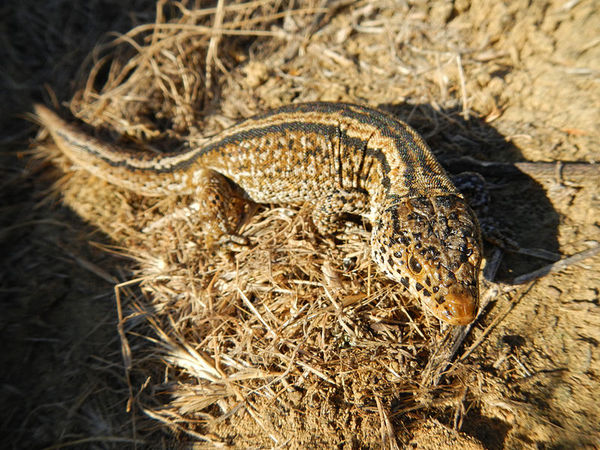
From KCET:
It hasn't hurt that all of the islands the night lizard calls home are owned by the federal government. San Clemente and San Nicolas islands are owned and managed by the U.S. Navy, while Santa Barbara Island and its tiny neighbor Sutil Island belong the the National Park Service. That's simplified tasks such as removing introduced predators and yanking out weeds.
In 2004, the Navy petitioned USFWS to delist the lizards on San Clemente and San Nicolas islands, claiming that each island's population was properly considered a Distinct Population Segment (equivalent to a species under the Endangered Species Act) and saying that the population of night lizards on each of the two islands had recovered.
That prompted a 2006 status review for the lizard, and in February 2013 USFWS finally got around to its response: a proposal that the lizard be delisted throughout its range. With this new ruling, scheduled for printing in the Federal Register on April 1, that delisting becomes official.
According to USFWS, estimates of the lizard's current population range from 15,300 on San Nicolas and 17,600 on Santa Barbara/Sutil, with an astonishing 21.3 million estimated for San Clemente Island. The estimates didn't count lizards, but merely assessed the acreage of lizard habitat on each island and used mathematical models to extrapolate estimated total populations.
Read more...
Photo: Ryan P. O'Donnell/Wikimedia Commons/Creative Commons License
Yesterday we made fun of the 49ers for banning reptiles from their new stadium. Now we feel bad, because apparently this is a thing: An Eastern brown snake turned up on an Australian rugby field the very next day.

From ABC Australia:
A one-metre brown snake on the NRL field at Robina took the ABC Grandstand commentary team by surprise, but it did not stop them from encouraging on-field reporter Zane Bojack to take a closer look, despite his professed herpetophobia.
You can read more and listen to the crowd and reporters here.
Tuesday, April 1 2014
 A Michigan firefighter went into a burning building to save a pet 6-foot python trapped in his terrarium.
From WXYZ:
Muskegon firefighter Scott Hemmelsbach told The Muskegon Chronicle that he reluctantly agreed to enter the two-story, smoke-filled house Sunday night to retrieve the snake. He says he cradled the "weighty" snake before carrying it to safety.
"It was trying to crawl up the side of his terrarium and get out," Hemmelsbach said. "His face was pushed up on the screen and trying to get out. There was a lot of smoke and he was trapped."
The firefighter said he learned how to handle snakes while he was at Grand Haven High School, where he helped showcase them.
Read more...
And thank you, Firefighter Hemmelsbach!
|


